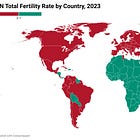Population Collapse: Fertility is More Limited by Age Than Young People Realize
People aren't having as many children as they want, because they believe things about age and fertility that simply are not true.
NOTE: Daniel Hess’s work on the growing demographic implosion — and what to do about it — is excellent. Be sure to follow him on X. — RDM
by Daniel Hess
February 19, 2025
Fertility plunged in the United States from about 2.05 births per woman in 2000 to just 1.6 births per woman in 2020, well below replacement amid a global crisis of low birthrates. But fertility desires did not change much at all during that time. Ideal fertility according to surveys has stayed around 2.5 births per woman since 1970, and perhaps has even increased a bit in recent years.
So why did births fall so much when fertility desires stayed about the same? Yale professor Paul Goldsmith-Pinkham recently posted great visuals that plot fertility across different ages over time. They offer a big clue about why women are not having all the children that they want to have.





